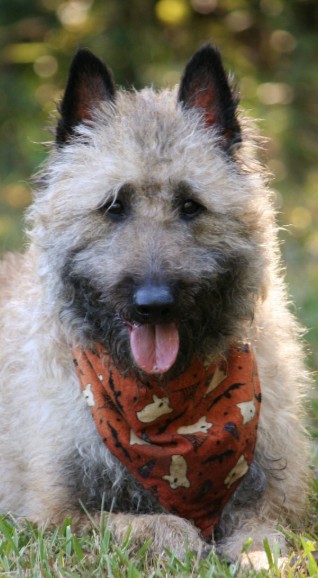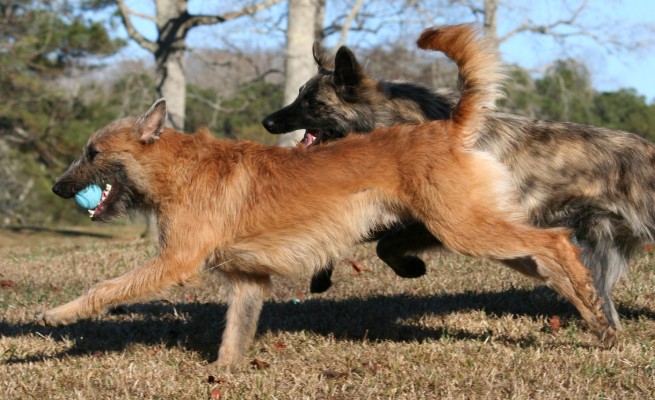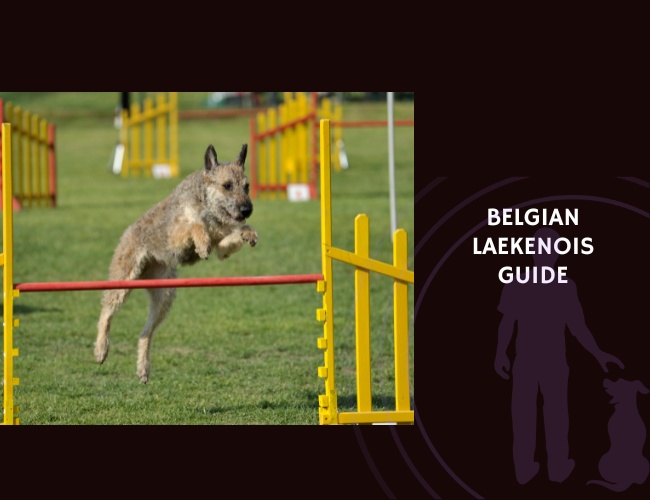Introduction: Meeting Belgium’s Hidden Gem
Picture a dog with the intelligence of a Border Collie, the loyalty of a German Shepherd, and a tousled, wiry coat that looks like it just rolled out of bed – that’s the Belgian Laekenois for you. As the rarest of the four Belgian Shepherd varieties, with fewer than 400 individuals in the United States, this remarkable breed carries centuries of herding wisdom in its alert amber eyes. Originally tasked with guarding linen drying in the fields of Laeken, Belgium, these dogs developed a unique combination of vigilance, independence, and devotion that makes them unlike any other companion you might encounter.
You might wonder what makes the Laekenois (pronounced “Lak-in-wah”) so special compared to its Belgian cousins – the Malinois, Tervuren, and Groenendael. While they share the same exceptional intelligence and working drive, the Laekenois brings something distinctive to the table: a primitive, intuitive thinking pattern that harks back to its heritage breed status. This means your Laekenois won’t just follow commands blindly; instead, they’ll assess situations and make independent decisions, a trait that can be both fascinating and challenging for modern dog owners.
Let us guide you through understanding this exceptional breed, from their complex behavioral patterns to their specific care needs. Whether you’re considering adding a Laekenois to your family or simply curious about these rare guardians, you’ll discover why those lucky enough to share their lives with one often describe it as a transformative experience. 🐾
Character & Behavior: The Heart of a Guardian
Understanding Your Laekenois’s Working Heritage
When you look into the eyes of a Belgian Laekenois, you’re seeing centuries of careful breeding for vigilance, intelligence, and protective instinct. These dogs didn’t just herd sheep in 19th century Belgium – they were entrusted with guarding valuable linen as it dried in the fields, a responsibility that required both fierce protection and gentle restraint. This unique heritage manifests in fascinating ways in your modern companion.
Your Laekenois maintains what behaviorists call “constant environmental scanning” – that subtle head tilt when a car passes three blocks away, or the way they position themselves between you and the doorway when visitors arrive. This isn’t anxiety or nervousness; it’s the expression of deeply embedded guardian genetics. You might notice your furry friend creating invisible boundaries around your property, patrolling perimeters with the dedication of a medieval sentry. This vigilant nature means they’re always “on duty,” even during what seems like casual backyard time.
The breed’s primitive nature – their classification as a heritage breed – means they possess an intuitive thinking pattern that sets them apart from many modern breeds. Where a Golden Retriever might immediately comply with a command, your Laekenois evaluates the situation first. Did you ask them to sit while a stranger approaches? They’ll consider whether sitting leaves you vulnerable before deciding. This independent thinking isn’t disobedience; it’s the hallmark of a dog bred to make split-second decisions protecting flocks from wolves without human guidance.
The Selective Bond: When Your Dog Chooses You
Perhaps no aspect of Laekenois behavior surprises new owners more than their selective bonding pattern. Unlike breeds that shower affection on everyone they meet, a Laekenois forms deep, almost spiritual connections with just one or two people in their lifetime. This bond formation typically solidifies between 18 and 36 months of age, during what experts call the “social maturity window.”
What this selective bonding looks like in daily life:
- Your Laekenois might follow you from room to room while merely acknowledging other family members
- They show markedly different enthusiasm levels when different family members return home
- Training responsiveness can vary dramatically between their “chosen person” and others
- They may position themselves to maintain visual contact with their primary handler at all times
This doesn’t mean your Laekenois won’t care for other family members – they absolutely will. Think of it like this: if family bonds were a solar system, you (their chosen person) would be the sun, family members would be planets in close orbit, and strangers would be distant asteroids. Everyone has a place, but the gravitational pull toward their chosen person remains strongest.
The intensity of this bond creates both beautiful moments and practical challenges. Your Laekenois doesn’t just want to be near you; they need that connection like they need water. Leaving them alone for extended periods isn’t just inconvenient for them – it can trigger genuine distress. Many owners describe their Laekenois as their “shadow,” and this isn’t mere clinginess but rather an expression of their deep-rooted pack mentality combined with their guardian instincts.
Navigating Protective Instincts Without Creating Reactivity
Your Laekenois comes equipped with natural protective instincts that would make any security system jealous. However, there’s a delicate balance between healthy protectiveness and problematic reactivity that you’ll need to navigate carefully. Understanding this distinction will shape your training approach and daily management strategies.
Natural protective behaviors in the Laekenois include alert barking at approaching strangers, positioning themselves between family and perceived threats, and showing increased vigilance during nighttime hours. These behaviors are hardwired and, when properly channeled, create a confident, reliable guardian. You might notice your dog’s entire demeanor shift when someone approaches your property – ears forward, body tense but controlled, a low warning bark that says “I see you” rather than “I’m scared.”
Environmental factors play a huge role in whether protective instincts tip into reactivity. Urban environments, with their constant stream of stimuli, can overwhelm a Laekenois’s threat assessment system. Every passing jogger, every delivery truck, every dog walking by becomes a potential threat to evaluate. In contrast, rural settings allow these dogs to establish clear territories and encounter fewer triggers, often resulting in calmer overall behavior.
The key to managing these instincts lies in teaching your Laekenois what we call “controlled alerting.” This means they can notify you of something unusual (their job), but then defer to your judgment about the threat level (your job as pack leader). This partnership approach respects their natural instincts while maintaining social appropriateness in modern settings.

Training & Education: Shaping Your Thinking Partner
Building a Working Partnership, Not Just Obedience
Training a Belgian Laekenois requires a fundamental shift in how you might think about dog education. You’re not just teaching commands; you’re developing a working partnership with a thinking, evaluating partner. This breed’s exceptional intelligence combined with their independent nature means traditional “do it because I said so” training often falls flat.
Your Laekenois thrives on understanding the “why” behind commands. When teaching something like recall, they perform best when they understand the purpose – are you calling them away from danger? Toward an activity? For no particular reason? Each scenario might get a different response speed based on their assessment. This isn’t stubbornness; it’s the thoughtful evaluation of a dog bred to make independent decisions. Successful trainers learn to communicate purpose along with commands, creating context that makes sense to their dog’s working mind.
The handler focus exhibited by a well-bonded Laekenois is something to behold. During training sessions, you might notice your dog’s eyes rarely leave your face, tracking micro-expressions and body language with an intensity that can feel almost telepathic. This attention to detail means they often anticipate commands before you fully give them, reading your intention through subtle cues you didn’t even know you were sending. Harnessing this focus requires consistency in your own body language and clear, predictable patterns in your training approach.
Creating effective training sessions:
- Keep sessions short but frequent (10-15 minutes, 3-4 times daily)
- Vary locations to build generalization of commands
- Include problem-solving exercises, not just rote obedience
- End on success, even if it means scaling back to an easier task
The Critical Window: Socialization That Shapes a Lifetime
The socialization period for your Laekenois puppy isn’t just important – it’s absolutely critical for their future stability and confidence. Between 3 and 14 weeks of age, your puppy’s brain is essentially downloading information about what’s normal and safe in their world. Miss this window, and you’ll spend years trying to retrofit confidence that could have been built in weeks.
During the primary socialization window (3-14 weeks), your puppy needs exposure to at least 100 different people, including children, elderly individuals, people wearing hats, people with mobility aids, and people of diverse ethnicities. This might sound excessive, but remember – your Laekenois’s selective nature means they default to suspicion of strangers. Every positive interaction during this period adds to their “safe human” database.
The secondary socialization period (14-20 weeks) focuses more on environmental confidence. Urban puppies need exposure to traffic, crowds, elevators, and city noise. Rural puppies need to encounter livestock, farm equipment, and wildlife without developing chase behaviors. During this time, you’re not just exposing them to stimuli; you’re teaching them how to process and recover from novel experiences.
Environmental conditioning continues through their first year, with the 5-12 month phase being crucial for cementing earlier lessons. Adolescent Laekenois often go through what trainers call “fear periods” where previously accepted stimuli suddenly become suspicious. Patient, positive re-introduction during these phases prevents permanent fear associations from forming.
Motivation and Reinforcement: Finding Your Dog’s Currency
Understanding what motivates your individual Laekenois transforms training from a chore into a collaborative joy. While every dog is unique, the breed tends to show distinct preferences in their reinforcement hierarchy that can guide your training approach.
Food rewards work brilliantly for initial learning phases, but Laekenois often show faster satiation than perpetually hungry breeds like Labradors. You might find that high-value treats (think freeze-dried liver or cheese) maintain attention for about 10 minutes before your dog’s interest wanes. Smart trainers keep sessions within this window and use meal times as training opportunities, making every kibble count toward education.
Play and toy rewards tap into the Laekenois’s high prey drive and working enthusiasm. A vigorous game of tug after a successful recall can be worth more than a handful of treats. The key is matching the reward intensity to the difficulty of the task – save the special squeaky ball for breakthrough moments, while verbal praise suffices for routine compliance.
Social rewards from their bonded handler often become the most powerful motivator as your relationship deepens. A genuine “good dog” with sincere emotion behind it, a chest scratch, or simply being allowed to work beside you can motivate a Laekenois more than any treat. This social motivation is why they excel in partnership activities like agility, herding trials, and protection sports.
Vigilant. Selective. Devoted.
A guardian’s mind endures. Centuries of protective duty have shaped the Belgian Laekenois into a watchful, independent thinker who evaluates before acting. Honouring this heritage means guiding rather than overriding their instincts, creating a partnership built on mutual respect.
Bonding is a rare gift. The Laekenois forms deep, lasting connections with only a select few, making their loyalty intense and unwavering. Nurturing this trust requires presence, consistency, and understanding of their need for emotional proximity to their chosen person.



Purpose fuels cooperation. Training thrives when it offers clear context, engages their problem-solving drive, and channels their protective nature constructively. By pairing structure with meaningful work, you turn instinct into dependable, willing partnership.
Nutritional Recommendations: Fueling Your Athlete
Calculating Energy Needs for Your Working Dog
Feeding a Belgian Laekenois isn’t as simple as following the guidelines on a dog food bag. These athletic, high-drive dogs have energy requirements that fluctuate dramatically based on their activity level, and understanding these needs prevents both obesity and undernourishment. Your Laekenois’s metabolism runs hot – they’re burning calories even when they appear to be resting, thanks to their constant environmental vigilance.
For a working Laekenois actively herding, doing protection work, or competing in dog sports, caloric needs can reach 30-40 kilocalories per pound of body weight. This means a 60-pound working Laekenois might need 2,400 calories daily – nearly double what a sedentary dog of the same size requires. Active companion dogs who enjoy daily runs, hikes, and training sessions typically need 25-30 kcal per pound, while those with moderate activity levels function well on 20-25 kcal per pound.
Weather plays a surprising role in your dog’s nutritional needs. During cold weather, that wiry coat provides excellent insulation, but maintaining body temperature still increases caloric requirements by 10-15%. You might notice your Laekenois eating heartily in winter while picking at their food during hot summer days. This isn’t fickleness – it’s intelligent biological adaptation. Rather than forcing meals during hot weather, consider feeding during cooler morning and evening hours when appetite naturally increases.
The timing of meals matters as much as the quantity. These dogs perform best on a split feeding schedule – two or three meals daily rather than one large meal. This approach prevents bloat, maintains stable energy levels throughout the day, and aligns with their natural grazing tendencies from their herding heritage.
Optimizing Macronutrients for Performance
Your Laekenois requires a careful balance of proteins, fats, and carbohydrates to maintain their muscular physique and sharp mental capacity. Think of their diet like premium fuel for a high-performance engine – the quality and ratio of nutrients directly impact their ability to work, think, and thrive.
Protein requirements for your Laekenois:
- Working dogs: 28-32% protein (dry matter basis)
- Active companions: 26-28% protein
- Senior or less active: 24-26% protein
The protein sources matter tremendously. High-quality animal proteins like chicken, lamb, fish, or venison provide complete amino acid profiles essential for muscle maintenance and repair. Your Laekenois’s active lifestyle creates constant micro-damage to muscle fibers that requires quality protein for recovery. Plant-based proteins can supplement but shouldn’t serve as primary sources for this athletic breed.
Fat serves as concentrated energy for endurance activities. Working Laekenois benefit from 15-20% fat content, while companion dogs maintain ideal condition on 12-15%. Omega-3 fatty acids from fish oil provide additional anti-inflammatory benefits, supporting joint health and cognitive function. A daily dose of 20-30mg of EPA/DHA per pound of body weight can make a noticeable difference in coat quality and mental sharpness.
Carbohydrates remain controversial in canine nutrition, but for your active Laekenois, complex carbs from sources like sweet potatoes, brown rice, or oats provide sustainable energy for their working muscles. Avoid simple sugars and excessive grain content, which can trigger inflammation and digestive upset in sensitive individuals.
Supporting Longevity Through Targeted Nutrition
Proactive nutritional support can significantly impact your Laekenois’s quality of life as they age. Starting joint support supplementation early – around age 2-3 years – may delay or prevent the onset of arthritis symptoms common in active, medium-to-large breeds.
Glucosamine and chondroitin supplementation provides building blocks for cartilage repair and maintenance. While young, healthy dogs produce these compounds naturally, supplementation creates a reserve that becomes crucial as natural production declines with age. For a 60-pound Laekenois, aim for 1000mg glucosamine and 800mg chondroitin daily, either through supplements or joint-support formulated foods.
Antioxidants become increasingly important as your Laekenois ages. Vitamins E and C, selenium, and beta-carotene combat oxidative stress that accumulates from years of athletic activity. Senior formulas often include these naturally through ingredients like blueberries, spinach, and carrots, but additional supplementation might benefit highly active or older dogs.
Digestive health requires special attention in this breed. Their sensitive stomachs and tendency toward food reactivity mean probiotic support can prevent many gastrointestinal issues. Look for foods containing live cultures or consider adding a quality probiotic supplement, especially during times of stress or dietary transition.

Health Management: Protecting Your Investment
Understanding Breed-Specific Health Challenges
While Belgian Laekenois enjoy relatively robust health compared to many purebred dogs, understanding their specific vulnerabilities allows for proactive management that can add years to your companion’s life. The breed’s rarity means less extensive health data exists compared to common breeds, making vigilant monitoring even more important.
Hip and elbow dysplasia affect an estimated 10-15% of the Laekenois population, though careful breeding practices continue to reduce these numbers. These conditions, where joints develop abnormally, can range from mild discomfort to debilitating lameness. Early detection through radiographic screening at 24 months allows for management strategies that can maintain quality of life for affected dogs. You might notice subtle signs like bunny-hopping when running, difficulty rising after rest, or reluctance to jump into the car – all potential early indicators worth investigating.
Progressive Retinal Atrophy (PRA) represents another concern in the breed. This genetic condition causes gradual vision loss, typically beginning with night blindness and progressing to complete blindness. While no cure exists, dogs adapt remarkably well to vision loss when it occurs gradually. Annual eye examinations by a veterinary ophthalmologist can detect early changes, allowing you to prepare your home environment and training approach accordingly.
The Laekenois’s distinctive wiry coat, while low-maintenance in many ways, can predispose them to certain skin conditions. Seasonal alopecia might cause temporary hair loss during shedding cycles, while the coat’s texture can trap moisture, creating an environment conducive to fungal infections. Regular grooming and attention to skin health prevent most issues, but some individuals show sensitivity to environmental allergens that manifest as skin irritation or recurring ear infections.
Cardiac Health in Athletic Breeds
While dilated cardiomyopathy (DCM) occurs less frequently in Laekenois than in some other large breeds, the condition deserves attention given the breed’s athletic demands. DCM causes the heart muscle to weaken and enlarge, reducing its ability to pump blood effectively. Early stages often show no symptoms, making regular veterinary screening crucial for detection.
Annual cardiac auscultation during routine veterinary visits provides basic screening, but active working dogs benefit from periodic echocardiograms to assess heart function more thoroughly. Warning signs that warrant immediate veterinary attention include exercise intolerance, coughing (especially at night), rapid breathing at rest, or fainting episodes. Caught early, medical management can significantly extend quality life years.
The relationship between diet and cardiac health has gained attention recently, particularly regarding grain-free diets and DCM. While research continues, current evidence suggests that some grain-free formulas might contribute to cardiac issues in predisposed dogs. Discussing your Laekenois’s diet with your veterinarian ensures you’re making informed choices based on the latest research.
Maximizing Longevity and Quality of Life
With an average lifespan of 10-12 years, your Laekenois falls within typical ranges for medium-to-large breeds. However, individual dogs regularly exceed these averages through careful management and preventive care. The key lies in maintaining physical fitness without overworking aging joints, providing mental stimulation that keeps cognitive function sharp, and addressing health issues proactively rather than reactively.
Regular veterinary checkups – twice yearly for seniors – catch problems before they become serious. Blood work can detect organ dysfunction early, while physical examinations identify lumps, joint problems, or dental disease requiring intervention. Many owners find pet insurance invaluable for managing unexpected health costs, particularly given the breed’s rarity might mean traveling to specialists for certain conditions.
Mental health matters as much as physical health for your aging Laekenois. Cognitive dysfunction syndrome, similar to dementia in humans, can affect senior dogs. Maintaining training routines, introducing puzzle feeders, and continuing socialization help preserve mental acuity. Signs of cognitive decline include disorientation, changes in sleep patterns, house training lapses, or altered interaction patterns with family members.
Lifestyle Integration: Making It Work
Rural Paradise vs. Urban Challenge
The environment you provide significantly impacts your Laekenois’s behavior, stress levels, and overall quality of life. While these adaptable dogs can thrive in various settings, understanding how different environments affect them helps you make necessary adjustments for success.
Rural settings align naturally with the Laekenois’s heritage. Acres to patrol satisfy their territorial instincts without overwhelming them with constant stimuli. The clear property boundaries common in rural areas make sense to their guardian mindset – they know exactly what they’re protecting. You might find your rural Laekenois develops a routine of perimeter checks, methodically inspecting fence lines at dawn and dusk just as their ancestors checked on grazing flocks.
Urban living presents unique challenges that require creative solutions. The constant stream of strangers passing your apartment door, the sounds of neighbors through walls, and the limited space for energy release can stress a Laekenois not properly prepared for city life. Success requires structured routines that provide both physical outlets and mental boundaries. Teaching a “city mode” where certain guardian behaviors are suppressed during walks, while allowing fuller expression in designated areas like dog parks or training facilities, helps urban Laekenois adapt.
Suburban environments often provide the best of both worlds – enough space for adequate exercise with access to training facilities and socialization opportunities. The typical suburban yard gives your Laekenois territory to guard without the overwhelming stimuli of dense urban areas. However, suburban challenges include close proximity to neighbors who might not appreciate alert barking and the need for secure fencing to prevent roaming.
Exercise Requirements: Beyond the Daily Walk
Meeting your Laekenois’s exercise needs requires creativity and commitment that goes far beyond a leisurely stroll around the block. These dogs were bred for all-day work, and while your companion dog doesn’t need to herd sheep for twelve hours, they do need outlets that engage both body and mind.
The bare minimum – and we stress minimum – is 60-90 minutes of structured exercise daily. But here’s the crucial point: a tired Laekenois is not necessarily a satisfied Laekenois. Physical exhaustion without mental engagement often creates a frustrated dog who’s too tired to misbehave but not satisfied enough to truly relax. The gold standard involves 2+ hours of combined physical and mental activity, broken into multiple sessions throughout the day.
Sample daily exercise routine for an adult Laekenois:
- Morning: 30-minute run or bike ride (physical)
- Midday: 15-minute training session (mental)
- Afternoon: 45-minute hike with sniffing opportunities (physical + mental)
- Evening: 20-minute agility or puzzle games (mental + light physical)
Activities that tap into breed-specific drives provide the most satisfaction. Herding trials offer the ultimate breed-appropriate outlet, allowing your Laekenois to use centuries of genetic programming. Even without access to sheep, games that involve gathering, sorting, or controlling movement (like teaching them to put toys away or “herd” family members to specific locations) engage herding instincts constructively.
Managing Separation: When You Can’t Be There
The Laekenois’s need for human companionship creates one of the biggest challenges for modern owners. These dogs don’t just prefer company – they’re psychologically wired to maintain pack cohesion. Leaving them alone fights against every instinct they possess, potentially triggering anxiety that manifests in destructive behavior, excessive barking, or depression.
Building separation tolerance must begin in puppyhood with careful, gradual conditioning. Start with mere seconds of separation, rewarding calm behavior before anxiety kicks in. Gradually extend duration, but never push past your puppy’s comfort threshold. The goal is teaching that separation is temporary and predictable, not abandonment.
For adult Laekenois, four to six hours represents the maximum recommended alone time, and even this requires proper preparation. Before departing, provide vigorous exercise to deplete energy reserves and create natural tiredness. Mental enrichment through puzzle toys, hidden treats, or frozen Kong toys provides occupation during your absence. Some owners find leaving a worn piece of clothing provides comfort through scent.
Technology offers modern solutions to separation challenges. Pet cameras allow you to monitor and even interact with your dog remotely. Some Laekenois respond well to hearing their owner’s voice through speakers, while others find this confusing. Doggy daycare, pet sitters, or arrangements with working-from-home neighbors can break up long days, preventing the cumulative stress of regular extended separations.
Grooming and Coat Management
That distinctive wiry coat that makes your Laekenois look perpetually windblown requires specific maintenance to remain healthy and functional. Unlike smooth-coated breeds that shed continuously, the Laekenois coat follows a different cycle that affects grooming requirements.
Hand-stripping, performed once or twice yearly, maintains proper coat texture and health. This process removes dead hair by the root, allowing new, healthy coat to grow. While some owners learn to hand-strip themselves, many prefer professional groomers familiar with wire-coated breeds. Between stripping sessions, weekly brushing prevents matting and distributes natural oils throughout the coat.
The coat provides excellent weather protection when properly maintained. That tousled appearance isn’t just aesthetic – the coat’s texture creates insulating air pockets that regulate temperature in both hot and cold weather. Shaving or clipping destroys this natural insulation and should be avoided except for medical necessity. Even in summer heat, the intact coat provides better temperature regulation than a clipped coat.
Seasonal shedding, while less dramatic than in double-coated breeds, still occurs. During these periods, daily brushing helps remove loose hair before it decorates your furniture. Many owners find that regular grooming sessions strengthen their bond with their Laekenois, as the dogs learn to enjoy the attention and physical contact.
Finding Your Perfect Match: Is the Laekenois Right for You?
The Ideal Laekenois Owner Profile
Success with a Belgian Laekenois depends less on your living situation and more on your lifestyle, experience, and commitment level. These dogs thrive with owners who view dog ownership as a central life priority rather than a pleasant addition to an already full schedule.
Previous experience with working breeds provides invaluable preparation for Laekenois ownership. If you’ve successfully raised a German Shepherd, Border Collie, or similar high-drive breed, you understand the dedication required. First-time dog owners can succeed with proper education and mentor support, but should honestly assess whether they’re ready for a dog who requires expert handling during critical development periods.
Your physical fitness matters more than your age. Laekenois need owners who can provide athletic exercise well into the dog’s senior years. This doesn’t mean you need to be a marathon runner, but you should comfortably handle daily hour-long walks, occasional runs, and have the stamina for training sessions after a full workday. Partners or family members who can share exercise duties provide helpful backup for busy periods.
Time commitment extends beyond exercise to training, grooming, and simple companionship. Budget three to four hours daily for dog-related activities. This might sound excessive, but remember – your Laekenois wants to be involved in everything you do. Reading with your dog at your feet counts as companionship time. Incorporating them into your existing activities often works better than viewing dog care as separate from your life.
Living Situation Considerations
While Laekenois can adapt to various living situations, certain environmental factors strongly influence their success and happiness. Secure fencing isn’t just recommended – it’s absolutely essential. These dogs will patrol boundaries, and without physical barriers, those boundaries might extend far beyond your property lines.
Neighbor tolerance for barking deserves honest assessment. Even well-trained Laekenois alert bark – it’s literally in their job description. While you can teach controlled alerting and quiet commands, you cannot completely eliminate this behavior without causing psychological stress. Neighbors who appreciate having a vigilant guardian nearby make ideal communities for Laekenois owners.
Access to training facilities or open spaces for off-leash exercise significantly improves quality of life for both dog and owner. While a large yard helps, it doesn’t replace the need for varied environments and socialization opportunities. The ideal situation combines secure home territory with regular access to different training venues.
The Long-Term Commitment
Bringing a Laekenois into your life means committing to 10-12 years (hopefully more) of intensive partnership. These dogs don’t rehome well due to their selective bonding patterns – choosing a Laekenois means seeing the relationship through to the end, regardless of life changes.
The emotional commitment might be the most demanding aspect. Your Laekenois will bond with you intensely, depending on you for guidance, companionship, and purpose. They’ll read your moods, share your activities, and occasionally challenge your decisions. This isn’t a dog who’ll contentedly snooze while you live your life – they want to be active participants in everything you do.
Conclusion: Embracing the Laekenois Journey
The Belgian Laekenois stands as a testament to what dogs can be when bred for intelligence, loyalty, and working capability rather than appearance alone. Their rarity isn’t just about numbers – it’s about the select group of owners who understand and appreciate what these exceptional dogs offer and demand in return.
Living with a Laekenois means accepting contradictions: a dog who’s fiercely independent yet deeply dependent on their chosen person, protective yet sensitive, primitive in thinking yet sophisticated in problem-solving. You’ll find yourself explaining to others that your dog isn’t unfriendly, just selective; not disobedient, just thoughtful; not neurotic, just vigilant.
The rewards for those who match well with this breed are immeasurable. The deep partnership that develops between a Laekenois and their person transcends typical pet ownership. You’re not just getting a dog; you’re gaining a working partner who’ll share your adventures, guard your home, challenge your training skills, and offer unwavering loyalty that touches something profound in the human-canine bond.
If you’re ready for the commitment – the early mornings for exercise, the ongoing training challenges, the constant companionship needs, and the occasional frustration of living with an independent thinker – then you might just be ready for a Belgian Laekenois. Just remember, when those amber eyes lock onto yours and that wiry-coated shadow follows you from room to room, you’re experiencing something rare and precious. Not everyone gets to share their life with one of Belgium’s hidden gems, but for those who do, life is never quite the same again. 🧡










